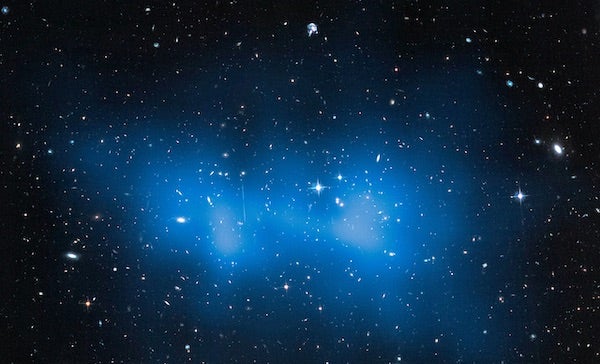
Q: In your feature, “Is the Big Bang in Crisis?” dark matter is called invisible. How was the dark matter in the story’s image of the El Gordo galaxy cluster detected and colorized if it is invisible?
William P. Gerhold — Hewitt, New Jersey
A: It is true that we cannot see dark matter directly. The blue color in the image of the El Gordo galaxy cluster (at left) was artificially added to show where the cluster’s dark matter resides. Similarly, you’ve probably seen composite images that include colorized X-rays, radio waves, and infrared light. Because the human eye can’t see all these wavelengths of light, astronomers take data at different wavelengths and combine it into a single image using different colors to show where unseen material exists.
To colorize the location of the dark matter, astronomers looked at visible matter (i.e., distant galaxies) behind the El Gordo cluster. Dark matter neither absorbs nor gives off light, which is why astronomers have named it dark. But because dark matter has mass, it does interact with normal matter — including photons (light) — via gravity. This causes an effect called gravitational lensing, which occurs when light from a distant background object passes near a massive object, whose gravity bends it. On Earth, we see that the background object’s image appears distorted — it may be spread out, smudged, magnified, or even duplicated. Based on the image we see, astronomers can calculate the amount and distribution of mass it took to create the distortion.
In the case of El Gordo, astronomers measured the mass of the galaxy’s normal matter using data from many observations. These include optical and infrared light, which reveal the amount of mass in stars and dust, and X-rays, which show the amount of mass in hot gas that often permeates galaxy clusters. Researchers then observed how the light from background galaxies that traveled through and around the cluster is distorted, and calculated the mass required to reproduce any warping they saw. The difference in the total mass required and the mass observed shows where the dark matter resides in the galaxy cluster, as well as where it is most concentrated or spread out. The result is a map of the galaxy’s dark matter, which was colorized (in this case, blue) and overlaid on an optical image to show where the dark matter is located.
Alison Klesman
This article was originally published Nov. 22, 2020.









